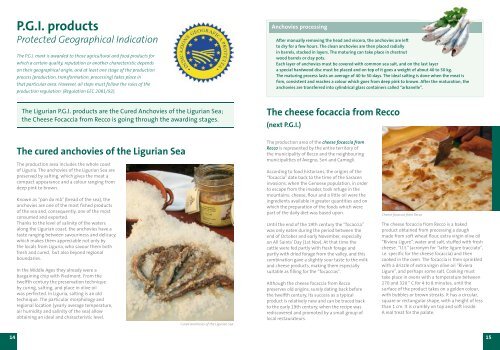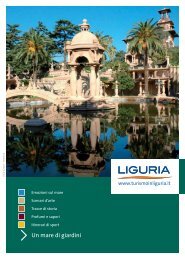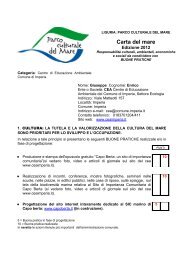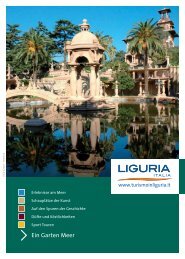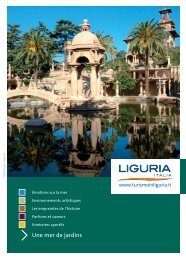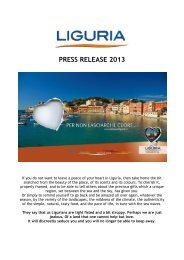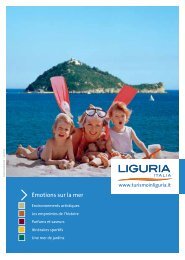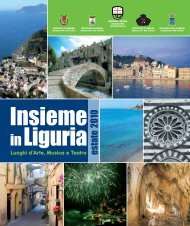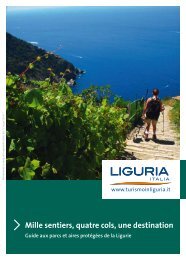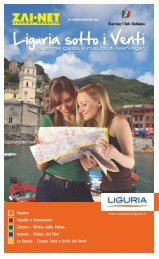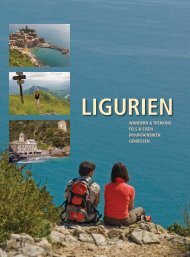Liguria, land of quality - Turismo in Liguria
Liguria, land of quality - Turismo in Liguria
Liguria, land of quality - Turismo in Liguria
You also want an ePaper? Increase the reach of your titles
YUMPU automatically turns print PDFs into web optimized ePapers that Google loves.
P.G.I. products<br />
Protected Geographical Indication<br />
The P.G.I. mark is awarded to those agricultural and food products for<br />
which a certa<strong>in</strong> <strong>quality</strong>, reputation or another characteristic depends<br />
on their geographical orig<strong>in</strong>, and at least one stage <strong>of</strong> the production<br />
process (production, transformation, process<strong>in</strong>g) takes place <strong>in</strong><br />
that particular area. However, all steps must follow the rules <strong>of</strong> the<br />
production regulation (Regulation EEC 2081/92).<br />
Anchovies process<strong>in</strong>g<br />
After manually remov<strong>in</strong>g the head and viscera, the anchovies are left<br />
to dry for a few hours. The clean anchovies are then placed radially<br />
<strong>in</strong> barrels, stacked <strong>in</strong> layers. The matur<strong>in</strong>g can take place <strong>in</strong> chestnut<br />
wood barrels or clay pots.<br />
Each layer <strong>of</strong> anchovies must be covered with common sea salt, and on the last layer<br />
a special hardwood disc must be placed and on top <strong>of</strong> it goes a weight <strong>of</strong> about 40 to 50 kg.<br />
The matur<strong>in</strong>g process lasts an average <strong>of</strong> 40 to 50 days. The ideal salt<strong>in</strong>g is done when the meat is<br />
firm, consistent and reaches a colour which goes from deep p<strong>in</strong>k to brown. After the maturation, the<br />
anchovies are transferred <strong>in</strong>to cyl<strong>in</strong>drical glass conta<strong>in</strong>ers called “arbanelle”.<br />
The <strong>Liguria</strong>n P.G.I. products are the Cured Anchovies <strong>of</strong> the <strong>Liguria</strong>n Sea;<br />
the Cheese Focaccia from Recco is go<strong>in</strong>g through the award<strong>in</strong>g stages.<br />
The cheese focaccia from Recco<br />
(next P.G.I.)<br />
The cured anchovies <strong>of</strong> the <strong>Liguria</strong>n Sea<br />
The production area <strong>in</strong>cludes the whole coast<br />
<strong>of</strong> <strong>Liguria</strong>. The anchovies <strong>of</strong> the <strong>Liguria</strong>n sea are<br />
preserved by salt<strong>in</strong>g, which gives the meat a<br />
compact appearance and a colour rang<strong>in</strong>g from<br />
deep p<strong>in</strong>k to brown.<br />
known as “pan do mâ” (bread <strong>of</strong> the sea), the<br />
anchovies are one <strong>of</strong> the most fished products<br />
<strong>of</strong> the sea and, consequently, one <strong>of</strong> the most<br />
consumed and exported.<br />
Thanks to the level <strong>of</strong> sal<strong>in</strong>ity <strong>of</strong> the waters<br />
along the <strong>Liguria</strong>n coast, the anchovies have a<br />
taste rang<strong>in</strong>g between savour<strong>in</strong>ess and delicacy,<br />
which makes them appreciable not only by<br />
the locals from <strong>Liguria</strong>, who savour them both<br />
fresh and cured, but also beyond regional<br />
boundaries.<br />
<strong>in</strong> the Middle ages they already were a<br />
barga<strong>in</strong><strong>in</strong>g chip with Piedmont. from the<br />
twelfth century the preservation technique<br />
by cur<strong>in</strong>g, salt<strong>in</strong>g, and place <strong>in</strong> olive oil<br />
was perfected. <strong>in</strong> <strong>Liguria</strong>, salt<strong>in</strong>g is an old<br />
technique. The particular morphology and<br />
regional location (yearly average temperature,<br />
air humidity and sal<strong>in</strong>ity <strong>of</strong> the sea) allow<br />
obta<strong>in</strong><strong>in</strong>g an ideal and characteristic level.<br />
Cured anchovies <strong>of</strong> the <strong>Liguria</strong>n Sea<br />
The production area <strong>of</strong> the cheese focaccia from<br />
Recco is represented by the entire territory <strong>of</strong><br />
the municipality <strong>of</strong> recco and the neighbour<strong>in</strong>g<br />
municipalities <strong>of</strong> avegno, sori and camogli.<br />
accord<strong>in</strong>g to food historians, the orig<strong>in</strong>s <strong>of</strong> the<br />
“focaccia” date back to the time <strong>of</strong> the saracen<br />
<strong>in</strong>vasions, when the genoese population, <strong>in</strong> order<br />
to escape from the <strong>in</strong>vader, took refuge <strong>in</strong> the<br />
mounta<strong>in</strong>s: cheese, flour and a little oil were the<br />
<strong>in</strong>gredients available <strong>in</strong> greater quantities and on<br />
which the preparation <strong>of</strong> the foods which were<br />
part <strong>of</strong> the daily diet was based upon.<br />
until the end <strong>of</strong> the 19th century the “focaccia”<br />
was only eaten dur<strong>in</strong>g the period between the<br />
end <strong>of</strong> october and early november, especially<br />
on all sa<strong>in</strong>ts’ day (1st nov). at that time the<br />
cattle were fed partly with fresh forage and<br />
partly with dried forage from the valley, and this<br />
comb<strong>in</strong>ation gave a slightly sour taste to the milk<br />
and cheese products, mak<strong>in</strong>g them especially<br />
suitable as fill<strong>in</strong>g for the “focaccias”.<br />
although the cheese focaccia from recco<br />
preserves old orig<strong>in</strong>s, surely dat<strong>in</strong>g back before<br />
the twelfth century, its success as a typical<br />
product is relatively new and can be traced back<br />
to the early 19th century, when the recipe was<br />
rediscovered and promoted by a small group <strong>of</strong><br />
local restaurateurs.<br />
Cheese focaccia from Recco<br />
The cheese focaccia from recco is a baked<br />
product obta<strong>in</strong>ed from process<strong>in</strong>g a dough<br />
made from s<strong>of</strong>t wheat flour, extra virg<strong>in</strong> olive oil<br />
“riviera Ligure”, water and salt, stuffed with fresh<br />
cheese. “l.l.t.” (acronym for “latte ligure tracciato”,<br />
i.e. specific for the cheese focaccia) and then<br />
cooked <strong>in</strong> the oven. The focaccia is then spr<strong>in</strong>kled<br />
with a drizzle <strong>of</strong> extra virg<strong>in</strong> olive oil “riviera<br />
Ligure”, and perhaps some salt. cook<strong>in</strong>g must<br />
take place <strong>in</strong> ovens with a temperature between<br />
270 and 320 ° c for 4 to 8 m<strong>in</strong>utes, until the<br />
surface <strong>of</strong> the product takes on a golden colour,<br />
with bubbles or brown streaks. it has a circular,<br />
square or rectangular shape, with a height <strong>of</strong> less<br />
than 1 cm. it is crumbly on top and s<strong>of</strong>t <strong>in</strong>side.<br />
a real treat for the palate.<br />
14 15


